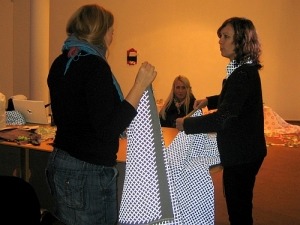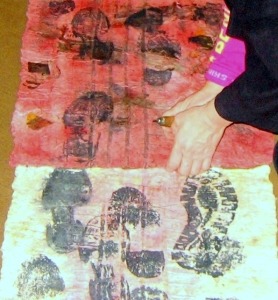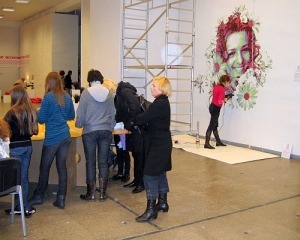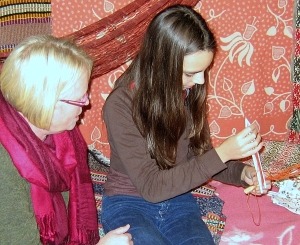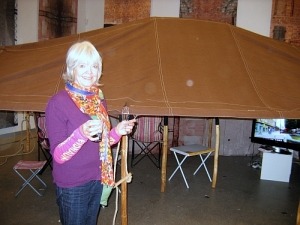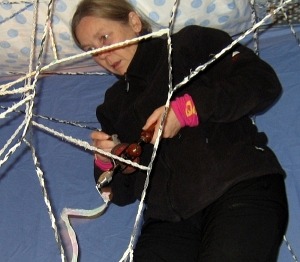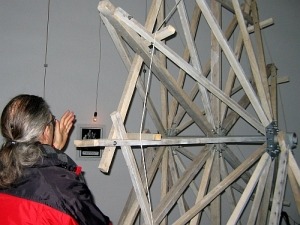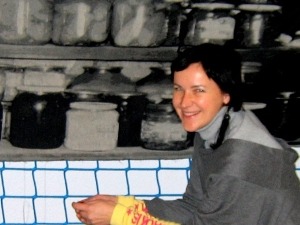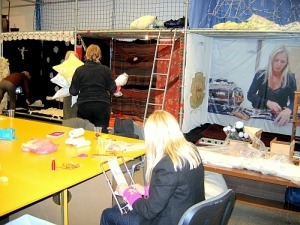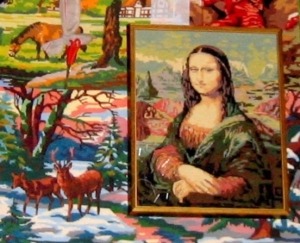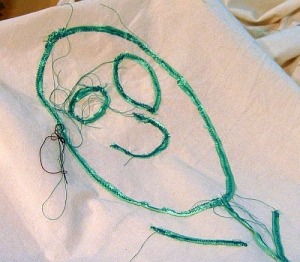ENTWINE, THREADS, OR ARTISTS’ GAMES WITH THE AUDIENCE IN KAUNAS BIENNIAL 0
Rūta Marcinkevičiūtė
www.kamane.lt , 2009 10 29
Fragment of work of Jūratė Kazakevičiūtė “Message from the Past”. Photos by R. Marcinkevičiūtė
Virginija Kirvelienė is sewing a strap from pieces tracked by visitors – it will be rolled into a ball later.
In brief: “Art is first of all human relations, an artwork always relates the author of the work and its viewer. The main currency we use as nomads, artists creating abroad, emigrants, tourists or refugees is also human relations,” the British artist Deirdre Cunningham stated.
The artist created the work “Nomadic Meetings in Kaunas” in the programme “Live Examination” of Kaunas biennial "Textile 09" for almost two weeks. In her opinion, it is very important that many world-famous artists gather in Kaunas in particular. It is a city always shadowed by the capital, and this year when Vilnius became the European capital of culture it is felt even more.
The chairman of the biennial council, the Irish living in Lithuania Ed Carroll also expects that this event should bring some fresh blood into the cultural life of Kaunas. In his opinion, "the organisers of the biennial are responsible that it would be accepted critically but not cynically, that the event would be trusted. It will be meaningful when the audience will experience artworks, when artworks will rally people, as art is a significant activity for everyone".
Therefore, in his opinion, Kaunas art biennial should create background for renewing cultural activity, invite like-minded people to discuss about culture of citizens. This should rally people of art and culture, awaken cultural life and let everyone share experience of other fields. The biennial of this year “Textile’09” tried to achieve this.
E.Carroll smiled that they invited guests of the exhibition directly to the kitchen, where everything was produced, they were welcome to observe how artworks were born and to participate in the process.
Pupils were occupied as much as artists in the biennial.
Birgitta Nordström teaches a visitor to make a net.
The head of Kaunas biennial, art critic Virginija Vitkienė noticed that works of all participants are slightly different than projects presented one year ago. Works are corrected by time, distance and situation. For example, artists from other countries do not even think that it is cold in Lithuania in October and that it is not the best time for art actions in the street.
The British artist D.Cunningham pitched a Berber nomad’s tent in various places of the city and observed passers-by who responded to questions of students who helped her. Later she moved the tent to the gallery space, analysed the project material and made it into a film.
British artist Deirdre Cunningham at her Berbers' tent.
“Nomadic Meetings” and the project of two London artists “Manufactured in Lithuania” reflect the wish of the organisers of the biennial of this year to involve as many spectators as possible into the artistic action. The Canadian Tracy Allen and Spanish artist Ruth Marquez opened a kiosk in Laisvės Alley and offered to passers-by to exchange labels of their clothes to personal signs created by the artists. The artists sewed all the collected labels into one big work presented in the exhibition.
Norwegian Anne Stabel wove a net by stranding pieces of bedclothes by a special device.
One could light a bulb by turning the mechanism created by the group Try3.
What should be preserved and how it should be done was the theme of considerations of two participants from Sweden. The project of Annika Akdahl and Birgitta Nordström “Shelter” looks like an exhibition in the exhibition.
Aušra Kleizaitė embroiders her shelter.
Shelters created by Anet Brusgaard from Denmark (on the right) and Anne Stabel from Norway.
The shelter is like a two-storeyed dormitory where every participant of the project has a possibility to furnish his/her room and offer colleagues and exhibition visitors to rest, think or work there.
The Swedish artist Annika Ekdahl was interested in textile kitsch.
Jams in the ladder is also heritage for Monika Žaltauskaitė-Grašienė.
One of the curators of the last biennial, director of London University, Goldsmiths College, Centre of Digital Studies, Research of Technologies and Culture Processes Janis Jefferies has noticed that it became clear a decade ago already that “the artist-researcher makes the biggest impact on the development of textile as the collection of material technologies as complicated system of semiotic signs now.” Newest technologies become more and more important, but there were almost no works created using them. Only the fabric used in the project of the Dutch artist Marielle Videler “Touch of a Weave” is coloured using paint produced according to a special technology – it shines and reflects bright light.
Modest grey fabric of Marielle Videler becomes really bright when illuminated by the camera’s flash.
The artist M.Videler searches for people who would agree to unstitch their favourite clothes and to sew copies from her fabric in every country she visits. When illuminated by light, such people wearing grey clothing turn into “stars”.
Lina Jonikė and Lina Gutauskienė turn the participants of their project “Wallpaper” into stars too. They offer them to share memories while looking at a wall with standard Soviet wallpaper. Later people and their thoughts are transferred to a silk wallpaper of 15 meters, which will be sold in an auction after the end of the exhibition.
Therefore, traditional techniques prevailed in the residency programme – Japanese created from special paper and old newspapers, Lithuanians used hand-made paper, sewed, weaved, embroidered. S.Inčirauskaitė-Kriaunevičienė and Agnietė Janušaitė-Vitkūnienė decided to refuse embroidery and created their work “Flower Portrait” from holes of different sizes drilled by a drill on the wall of the Picture Gallery.
Video cameras were used for documenting the creation process. They were also used in the project “Texts are here” of Inga Likšaitė: she established an artists' club in the lobby of the concert hall of Vytautas Magnus University for six days, where lectures, poetry was read, one could listen to music.
The first part of the programme "Live Examination" of Kaunas biennial, which lasted for the entire October, has ended. 60 artists from 20 countries created in front of the audience at Kaunas Picture Gallery and M.Žilinskas Art Gallery. On the 30th of October the exhibition of the biennial participants was opened. Visitors will be offered excursions in the exhibition that will be conducted by well-known artists and art critics.
In addition to the main exhibition of "Textile'09", the audience may visit another 9 satellite exhibitions in various Kaunas galleries. “Passionate Lithuanian Textile” and exhibition of the Polish artist W.Cygan “Behind Me” is presented at M. Žilinskas Art Gallery. The international exhibition “Asia-Europe. Art of Fibre” may be visited in Balta gallery. Works of four textile students and four lecturers may be seen at Kaunas Picture Gallery.
The gallery Meno Parkas presented the exhibition of the group Baltos Kandys “Festival” and “Portrait Image” of A.Janušaitė. From the 29th of October the exhibition “Other Stories” of the Mexican artist T.Candiani was opened. “Lost Portraits” of S.McGuinness (Ireland) is presented in the same gallery as well.
Fragment of the new work of the winner of last biennial, Mexican artist Tania Candiani.
The installation “Chasing Shadows” of E. and P.Pritchards (Great Britain) was organised at Kaunas Zoo Museum. A special educational event “Train B” (more than 50 events and excursions) has been prepared for visitors, family weekends are organised.
The abundance of exhibitions and events is targeted at the audience. However, a question arises whether an average statistical art lover is able to visit so many textile exhibitions, even in two months? Aren’t projects really worth attention lost among the big number of biennial events? The biennial lacked advertisement during the first month, its pink posters do not attract attention in autumn streets of Kaunas, while daily announcements of events sink in the flow of other news.
When asked about the textile biennial, many Vilnius and Kaunas artists and art critics did not know about “Textile‘09” and added that they were not interested in textile. Textile as such is used in other fields of art – objects, installations, media art. If artists willing to get to the biennial had to compete with creators of other fields, would there be place left for graduates of textile departments in exhibitions? One should try this in order to know the situation.
Perhaps it is worth to take the risk and show the hidden end of the thread to rivals and simply to organise Kaunas art biennial instead of textile art biennial after two years? It would be another experiment of the biennial organisers open to changes.









